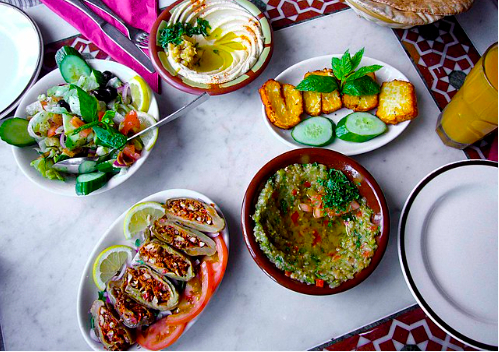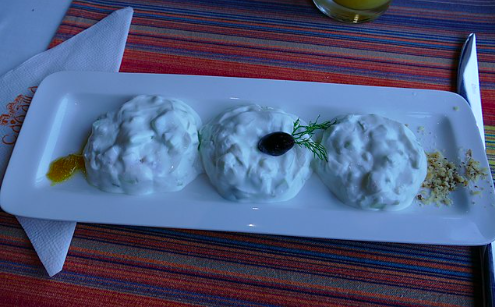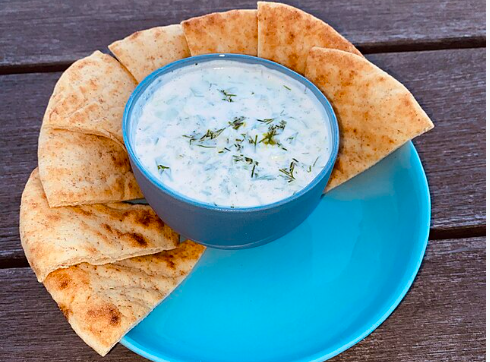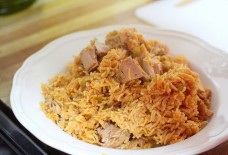The Foods of Eternal Damascus

By: Habeeb Salloum/Arab America Contributing Writer
The Byzantine Emperor Justinian called it `the light of the Orient’; the writer Maurice Barres is reported to have said `Damascus is not a mere area of land, it is the place of the soul’; and the Prophet Muhammad reportedly refused to enter the city, and at the same time, which he labelled `heaven on earth’. He preferred to wait for the heavenly Paradise. Through the centuries, such have been the epithets with which men have described Damascus – the oldest continuously inhabited urban centre on earth.
Aramaeans, Assyrians, Persians, Greeks, Romans, Byzantines and, above all, the Umayyad Arabs of the 7th century, left a rich legacy in all areas of the city’s daily life, especially in its food. Damascene products became common throughout the their vast empire and the incoming wealth created a demand for grand palaces and splendid mosques, along with a taste for fine foods.
Due to Syria’s rich history, Damascus and Aleppo developed a gourmet cuisine, not yet well known in other lands. In the ensuing centuries, other Middle Eastern cities only copied the foods of these historic urban centres, as well as those of Baghdad . Today’s, more well-known Lebanese and Palestinian foods are only an extension of those developed in the kitchens of the cities of Damascus and Aleppo in their days of splendour.
To taste the Damascene cuisine, developed through the centuries, one must dine in the peoples’ restaurants – not in the large hotels. These cater to Western visitors and, to a large extent, have abandoned the venerable foods of the city. In the heart of old Damascus, the ovens defusing the enticing odours of thyme and cheese and the mouth-watering aroma of succulent yakhnies (stews) are a testimony to the city’s delightful time-tested foods.
Besides, peoples’ eating places, almost all the city’s homes keep the culinary art of the city alive and well. There is no doubt that Eternal Damascus, where Alexander the Great and the Arab caliphs once strolled has, after centuries of civilization, developed one of the finest of the world’s kitchens. These few recipes are only a minuscule sample of the hundreds of Damascene dishes.
Damascus Garlic Appetizer – Thoum

Serves about 6
1 cup mashed potatoes
6 gloves garlic, crushed
1/4 cup olive oil
1/4 cup plain yogurt
salt and pepper to taste
8 black olives, pitted and sliced in half
4 medium radishes, sliced
Place potatoes, garlic, olive oil, yogurt, salt, pepper; in a food processor, then process until smooth. Place on a platter then decorate with olives and radishes. Chill then serve.
Burghul and Yogurt Appetizer – Kishkeh

Serves about 6
1/2 cup medium burghul, soaked for 10 minutes in warm water; then drained by squeezing out water through a strainer
1 cup plain yogurt
2 cloves garlic, crushed
1 teaspoon finely crumpled dried mint
4 tablespoons finely chopped cucumber
salt and pepper to taste
2 tablespoons finely chopped fresh coriander leaves
2 tablespoons olive oil
Combine all ingredients, except coriander and olive oil then spread on a platter on a platter. Chill, then decorate with coriander and sprinkle with olive oil just before serving.
Lentil Dumplings – Haraq Isba’hu
Serves 8 to 10
A dish unique to Damascus, haraq isba’hu is a wholesome addition to any meal.
1 cup lentils, rinsed
7 cups water
1/2 lb bread dough
salt and pepper to taste
1/2 teaspoon cumin
1/8 teaspoon cayenne
3 tablespoons lemon juice
4 tablespoons olive oil
1 large onion, chopped
1/2 cup finely chopped fresh coriander leaves
4 cloves garlic, crushed
vegetable oil
Place lentils and water in a saucepan and bring to boil then cover and cook over medium heat for 30 minutes.
In the meantime, roll dough to about 1/8-inch thickness then cut into 1/2-inch squares. Add 1/2 of the squares, salt, pepper, cumin and cayenne to the lentils then cook for a further 15 minutes or until the dough is cooked. Add lemon juice and stir; then set aside but keep hot.
Heat oil in a frying pan then sauté onion until light brown. Stir frying pan contents into lentils.
In the same frying pan, add vegetable oil and deep-fry remainder of dough squares until they turn light brown. Remove with a slotted spoon and place in a serving dish then set aside.
Combine coriander and garlic then place in another serving dish and set aside.
Serve lentils in soup bowls with each diner adding fried bread and coriander/garlic to taste.
Chickpea and Yogurt Platter – Fattat Hummus
Serves 6
In Damascus, this dish is usually served as a part of a hearty breakfast.
2 medium loaves Arabic bread (pita), toasted then broken into small pieces
1 can chickpeas (540 ml – 19 oz), drained
1 cup plain yogurt
1 clove garlic, crushed
salt and pepper to taste
seeds of one pomegranate
2 tablespoons lemon juice
1 tablespoon tahini
2 tablespoons butter
4 tablespoons pine nuts or slivered almonds
2 tablespoons chopped parsley
Spread bread evenly on a platter; then spread chickpeas evenly over top and set aside.
Thoroughly combine yogurt, garlic, salt, pepper, pomegranate seeds, lemon juice and tahini then spread over chickpeas. (If too thick, add a little water.)
Melt butter in a frying pan; then sauté pine nuts or almonds until they begin to brown. Spread nuts over yogurt mixture then decorate with parsley and serve.
Check out our Blog here!








